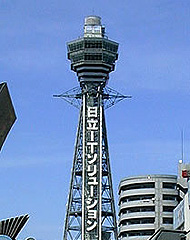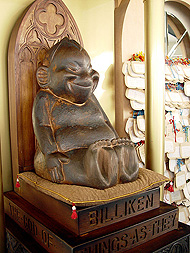
Travel Guide
 |
| Tsutenkaku |
 |
| Biliken |
Introduction
Tsutenkaku literally means “The tower reaching to heaven”. It is a tower and well-known landmark of Osaka, Japan. A visit to the Tsutenkaku is a visit to the heart and soul of Osaka. Take an hour or two enjoying the towering, eight-sided construct, the magnificent view it provides and the statue of Billiken, a god of good fortune.
Tsutenkaku is located in the Shinsekai (a new world) district of Naniwa-ku, Osaka. Despite its name, Tsutenkaku stands at 103 meter which is not an uncommon height for buildings in any cities like Osaka. With an observation platform on the 5th floor with a bird's eye view of Osaka and Billiken, Japanese for the God of Happiness or “things as they should be”. It is believed that Billiken could bring good luck if you rub the soles of his feet. The Billiken is an auspicious American doll that shipped its way to Japan way back in 1910. After its destruction, the statue of the toy went missing. The present shape is a reformation of the original as was copied from photographic evidence, which was positioned inside it in 1979. Presently, the statue has become closely associated with the tower and is a popular symbol of good luck.
Before stepping into the tower, remember to look out for the big 8-sided clock on the east side of the tower. Not only colorful, it changes color every minute, this clock is also said to be the biggest in Japan!
If you don’t have time to queue up, visit the tower at night when neon lights highlight each of its eight sides in spectacular fashion. Though they are mostly advertisements, the lights make for a perfect beacon to keep your bearings while you explore the downtown area.
The tower attracts 700,000 people every year. In 2007, Tsutenkaku was registered as a tangible cultural property of Japan.
History
The original tower that was built in 1912 actually did live up to its name as the second tallest building in Asia and the tallest in Japan. The design was also unique for Japan as it was modeled over the Eiffel Tower and Ard de Triomphe. On the break of World War II, the tower was demolished for its steel to be used in the war. The current tower that stands in Shinsekai now was built in 1956 by the local residents who as a symbol of love of the original one. At 103 m, the new Tsutenkaku is 39 m higher than the original. The new tower still carries the same name but with a different ‘face’, to be exact 8 different ‘faces’ on the tower building.
Travel Advice
Sightseeing
- Another little known secret about Tsutenkaku is also its neon weather forecast on the tower’s turret. This is indeed a creative work from the minds of Japanese. The neon turret has a combination of 3 different colors to indicate the next day’s weather and its changes. White for a clear day, blue for a rainy day and orange for a cloudy day.
- The area around Tsutenkaku is known as Sinsekai, whichi is "new world" in Japanese. Sinsekai was developed before the war and then neglected in the decades afterwards. Noted attraction here is kushikatsu, one of Osaka's best known specialties. It is a dish, composed of various skewered, battered and deep fried foods. Varieties on offer range from chicken and beef, to pumpkin and asparagus, to the banana and ice cream dessert varieties. Many of Shinsekai's kushikatsu restaurants are open 24 hours, but only truly come alive when the lights come on at night.
- Shinsekai is also home to Spa World, a huge bath complex with a large number of pools on a European themed floor and an Asian themed floor (enjoyed naked and gender separated). The floors are switched between genders each month. Natural hot spring water is pumped up from far below the earth's surface.
Facilities
| Observation Deck | ||
| Admission | Adult: 800 yen Student: 400 yen |
Adult: over 16 Child: 5 to 15 Group tickets are available |
Visit
| Address | 1-18-6 Ebisu-higashi, Naniwa-ku, Osaka City, Osaka | |
| Phone | 06-6641-9555 | |
| Admission | Free | |
| Hours | 09:00 to 21:00 | Entry until 30 minntes before closing |
| Closed | Open 7 Days a Week | |
| Duration | 15 min | |
| Getting There | By Train 10 minute walk from Shin-Imamiya Station on JR Osaka Kanjosen. 3 minute walk from No.3 exit of Ebisucho Station on subway Skaisuji Line. 10 minute walk from Dobutsuen-mae Station on subway Midosuji Line. 3 minute walk from Ebisucho Station on Hankai Line. Take City Bus to the Subway Ebisucho bus stop, then walk approximately 3 minute3. By Car Take Hanshin Expressway to the Yuhigaoka exit and take National Highway route 282 and 341. It is approximately 40 minutes from exit. |
|
| Parking | No parking available | |

